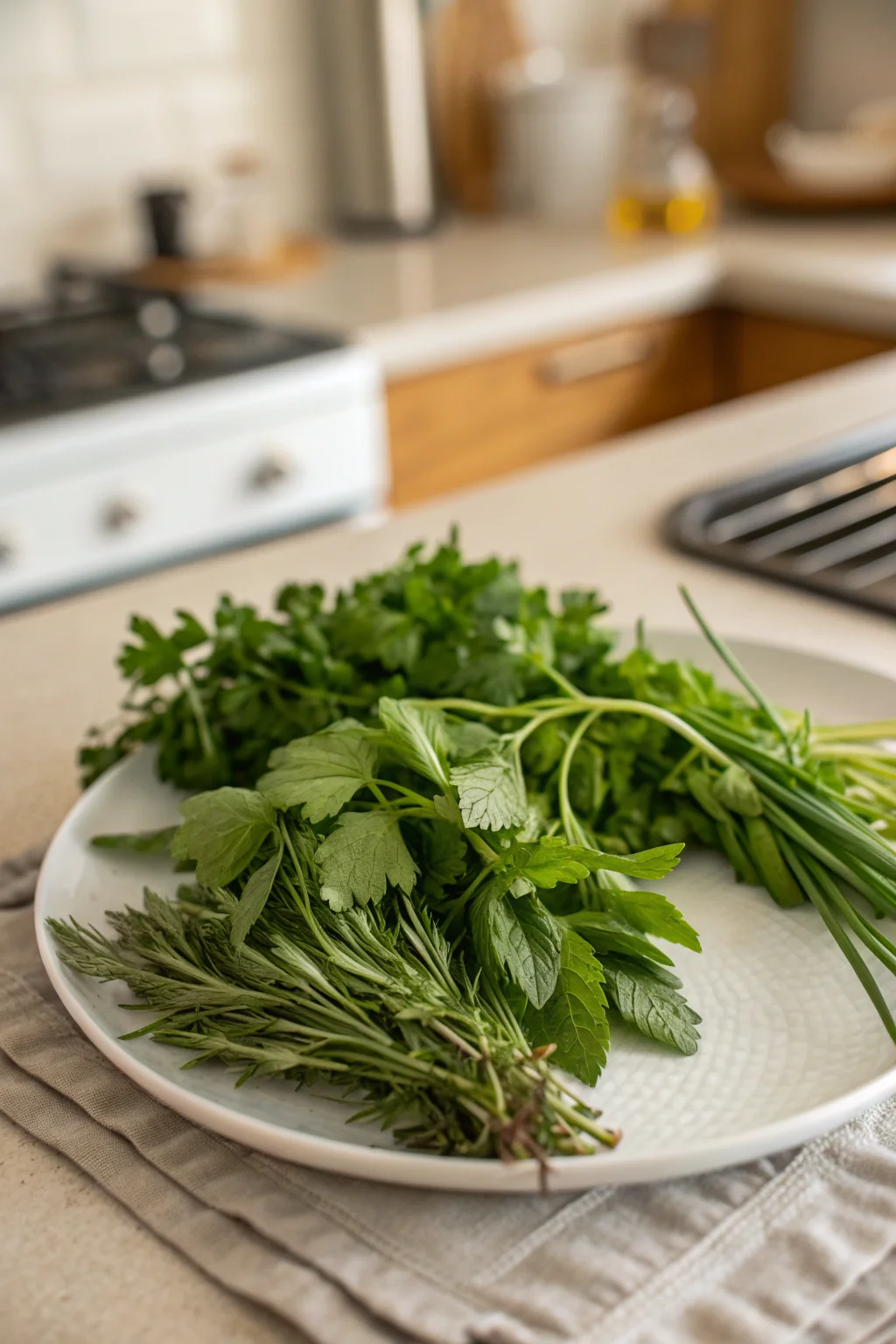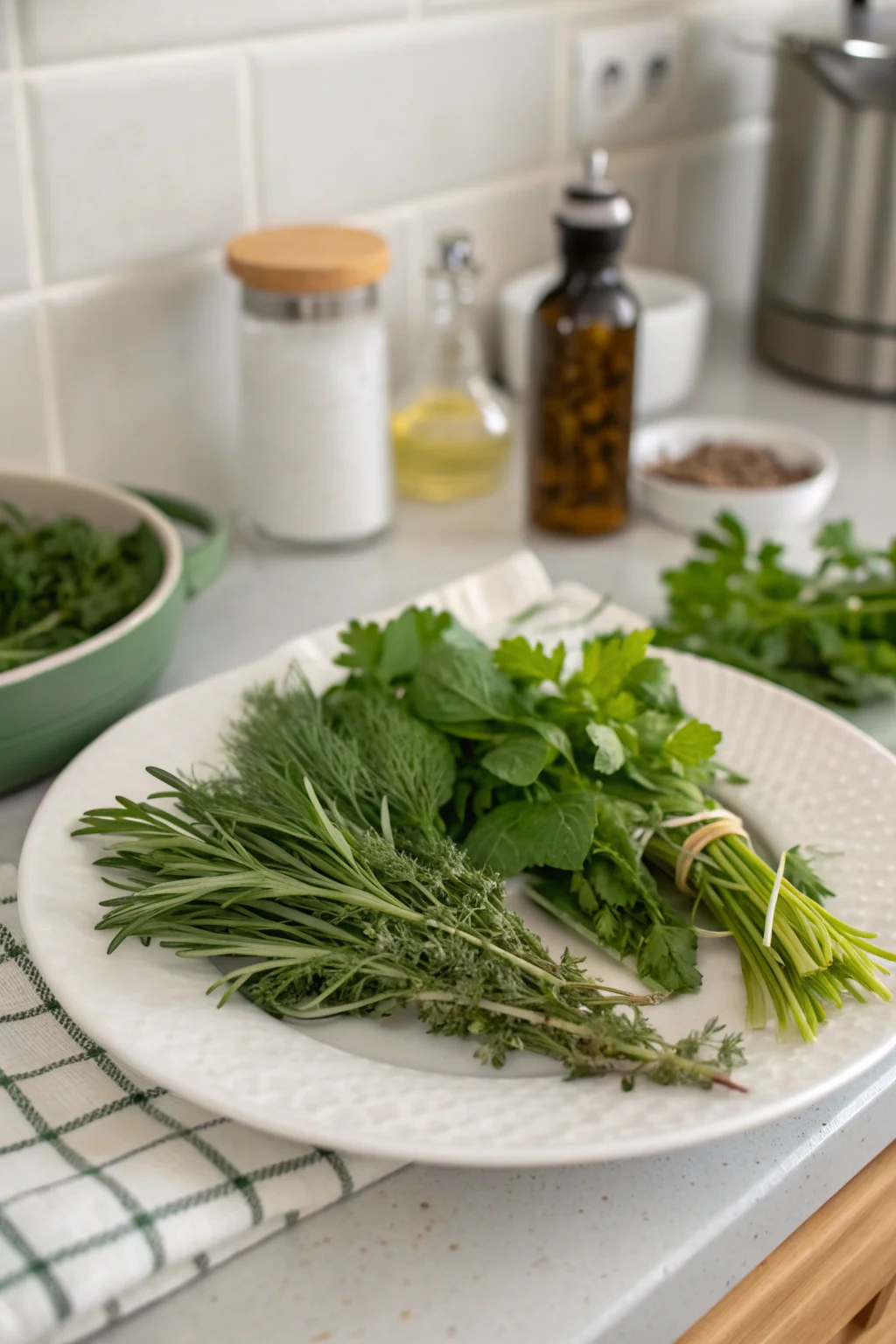How to Store Fresh Herbs So They Last Longer
Fresh herbs can elevate any dish, adding vibrant flavor and aroma. However, keeping them fresh can be a challenge. With the right storage techniques, you can extend the life of your herbs and enjoy their benefits longer. In this guide, we’ll answer common questions about storing fresh herbs effectively.
Table of Contents
What are the basic steps to store fresh herbs?

Storing fresh herbs properly begins with a few simple steps:
- Wash and Dry: Rinse herbs gently under cool water to remove dirt and debris. Pat them dry with a paper towel or use a salad spinner. Ensuring your herbs are clean and dry is crucial, as excess moisture can accelerate spoilage. A salad spinner is particularly effective for leafy herbs, as it removes water without bruising the leaves.
- Trim the Stems: For herbs with stems like basil and parsley, trim about an inch off the bottom to allow better water absorption. Trimming also helps remove any parts of the stem that might be damaged or dried out, ensuring the healthiest parts of the plant are preserved.
- Choose the Right Method: Depending on the type of herb, you may use the water method or the refrigerator method. Identifying the correct method for each herb ensures that they are stored under the optimal conditions for their type.
These basic steps will prepare your herbs for optimal storage and longevity.
How should I store leafy herbs like basil and cilantro?
Leafy herbs such as basil and cilantro thrive with the water method:
- Basil: Place trimmed stems in a jar with water, cover with a plastic bag, and keep at room temperature. Change the water every couple of days. Basil is sensitive to cold and can turn black if refrigerated, so room temperature storage is best. Keeping it on a sunny windowsill can also encourage continued growth.
- Cilantro: Store in a jar of water in the fridge, covered loosely with a plastic bag. Replace the water regularly. Cilantro’s delicate leaves benefit from the cooler environment of the fridge while still needing hydration. Make sure the plastic bag is not tightly sealed, as the herbs need to breathe.
These methods help maintain freshness by providing necessary hydration and protection from excess moisture. Additionally, ensuring that the leaves do not touch the water can prevent them from becoming slimy.
What is the best storage method for woody herbs like rosemary and thyme?
Woody herbs such as rosemary and thyme prefer a dry environment:
- Wrap them in a slightly damp paper towel. The moisture from the damp towel provides the right level of humidity that prevents them from drying out without encouraging mold.
- Place in a resealable plastic bag or airtight container. Sealing them properly prevents exposure to air, which can dry them out.
- Store in the fridge’s crisper drawer. The crisper drawer is designed to maintain higher humidity levels, which is ideal for storing herbs.
This method helps maintain the herbs’ texture and flavor by preventing excess moisture that can lead to mold. The structure of woody herbs is more robust, allowing them to retain their oils and flavors better when stored dry.
Can I freeze fresh herbs? If so, how?
Yes, freezing is a great way to extend the life of your herbs:
- Whole Leaves: Spread leaves on a baking sheet in the freezer. Once frozen, transfer to a labeled freezer bag. This flash freezing technique prevents the leaves from clumping together, making it easy to take out only what you need.
- Herb Cubes: Chop herbs and mix with olive oil or water in an ice cube tray. Freeze and store in bags. These cubes can be added directly to soups, stews, or sauces, imparting fresh flavor as they melt.
Freezing helps preserve flavor and is a convenient way to have herbs on hand for cooking. The process of freezing can sometimes alter the texture of herbs, making them more suitable for cooked dishes rather than garnish.
How do I store fresh herbs in the fridge?

For refrigerator storage:
- Wrap: Lay herbs on a damp paper towel and roll up gently. This creates a humid microenvironment for the herbs, keeping them fresh longer.
- Bag: Place the wrapped herbs in a plastic bag or airtight container. This further seals in moisture while protecting from the drying effects of cold air.
- Placement: Store in the crisper drawer where humidity levels are higher. This is particularly effective for herbs like parsley, dill, and tarragon.
This method works well for most herbs and helps maintain their freshness and color. It’s important to regularly check the condition of stored herbs, as some may need rewrapping or a change of paper towel if they become too damp.
Should I store herbs in water or dry?
The choice depends on the herb type:
- Water Method: Ideal for soft-stemmed herbs like basil and cilantro. This method mimics the way these herbs grow naturally, ensuring they stay alive and fresh.
- Dry Method: Better for woody herbs like rosemary and thyme. These herbs have a lower water content and benefit from a drier environment.
Using the correct method ensures herbs retain their quality and last longer. Misidentifying the appropriate storage method can lead to premature wilting or mold growth.
How long do fresh herbs typically last?
Fresh herbs can last from a few days to a few weeks:
- Soft Herbs: Like basil and cilantro, usually last 1-2 weeks. Their delicate nature means they are more susceptible to wilting.
- Woody Herbs: Like rosemary and thyme, can last up to 3 weeks. Their hardier structure allows them to retain essential oils longer, preserving flavor.
Proper storage techniques can help maximize these timelines. Regularly inspecting and maintaining your herbs can also help identify any that might need to be used quickly.
Can I use a herb keeper for storing fresh herbs?
Yes, herb keepers are convenient for storing fresh herbs:
- Design: They typically have a water reservoir and a tall container to hold herbs upright. This setup mimics the natural environment of the plant, keeping it hydrated and upright.
- Benefits: Keeps herbs hydrated and protected, extending freshness. The design also allows easy access and visibility, making it simple to incorporate fresh herbs into your cooking.
Herb keepers are a practical solution for those who frequently cook with fresh herbs. They are especially beneficial for those who purchase herbs in bulk and need to keep them fresh for longer periods.
How do I know if my herbs have gone bad?
Signs that herbs have gone bad include:
- Discoloration: Yellow or brown leaves. This can indicate that the herbs are past their prime or have been exposed to too much moisture or air.
- Texture: Slimy or wilted leaves. This is often a sign of excess moisture or bacterial growth.
- Smell: Off or sour odor. Fresh herbs should smell fragrant; any deviation may indicate spoilage.
If you notice these signs, it’s best to discard the herbs to avoid affecting the taste of your dishes. Using spoiled herbs can introduce unwanted flavors and textures into your meals.
What are common mistakes to avoid when storing herbs?
Avoid these mistakes for longer-lasting herbs:
- Overcrowding: Crowding herbs can cause bruising and faster spoilage. Ensure each stem has enough space to breathe, particularly when using the water method.
- Ignoring Water Levels: Change water regularly if using the water method. Stale water can harbor bacteria, which can spoil your herbs.
- Excess Moisture: Keep herbs dry to prevent mold. Only use a slightly damp towel for woody herbs, and ensure there is no standing water in storage containers.
Proper attention to these details can significantly impact the shelf life of your herbs. Regularly inspecting your storage setup ensures that conditions remain optimal for herb preservation.
Can I dry herbs at home for long-term storage?
Yes, drying herbs is an excellent long-term storage option:
- Air Drying: Tie stems together and hang upside down in a dry, dark place. This method preserves the natural oils and flavors of the herbs, making them ideal for seasoning.
- Oven Drying: Spread herbs on a baking sheet and dry at low heat. This is a faster method but can sometimes diminish the flavor if not monitored closely.
Dried herbs can last several months when stored in an airtight container away from light. They offer a concentrated flavor and are perfect for cooking when fresh herbs aren’t available.
What containers are best for storing fresh herbs?
Choose containers that allow for air circulation and moisture maintenance:
- Plastic Bags: Resealable bags are simple and effective. They are widely available and can be used for both the water and dry methods.
- Glass Jars: Great for water method storage. They provide stability and allow you to see the condition of the herbs easily.
- Herb Keepers: Designed specifically for herb storage. These containers often combine the benefits of both bags and jars, offering an integrated approach to storage.
Proper containers help maintain the right conditions for herb longevity. The choice of container can impact how well the herbs stay fresh and flavorful.
Are there any herbs that should not be refrigerated?
Yes, some herbs are sensitive to cold temperatures:
- Basil: Preferably stored at room temperature with the water method. Cold temperatures can damage its delicate leaves, causing them to blacken.
- Mint: Can be refrigerated but lasts longer with proper moisture control. Mint’s aromatic oils are best preserved at slightly warmer temperatures.
Understanding each herb’s needs ensures they remain fresh and flavorful. It’s essential to tailor your storage methods to the specific requirements of each herb type.
Conclusion
Storing fresh herbs correctly can significantly enhance their shelf life and preserve their vibrant flavors. Whether you’re using them in a simple salad or a complex dish, having fresh herbs on hand can make all the difference. By following these tips, you can enjoy your herbs for weeks. For more on enhancing your kitchen skills, check out our guide on keeping produce fresh and learn more about herb gardening basics. For further reading, explore external resources like The Spruce Eats for more detailed guides on herb storage.






